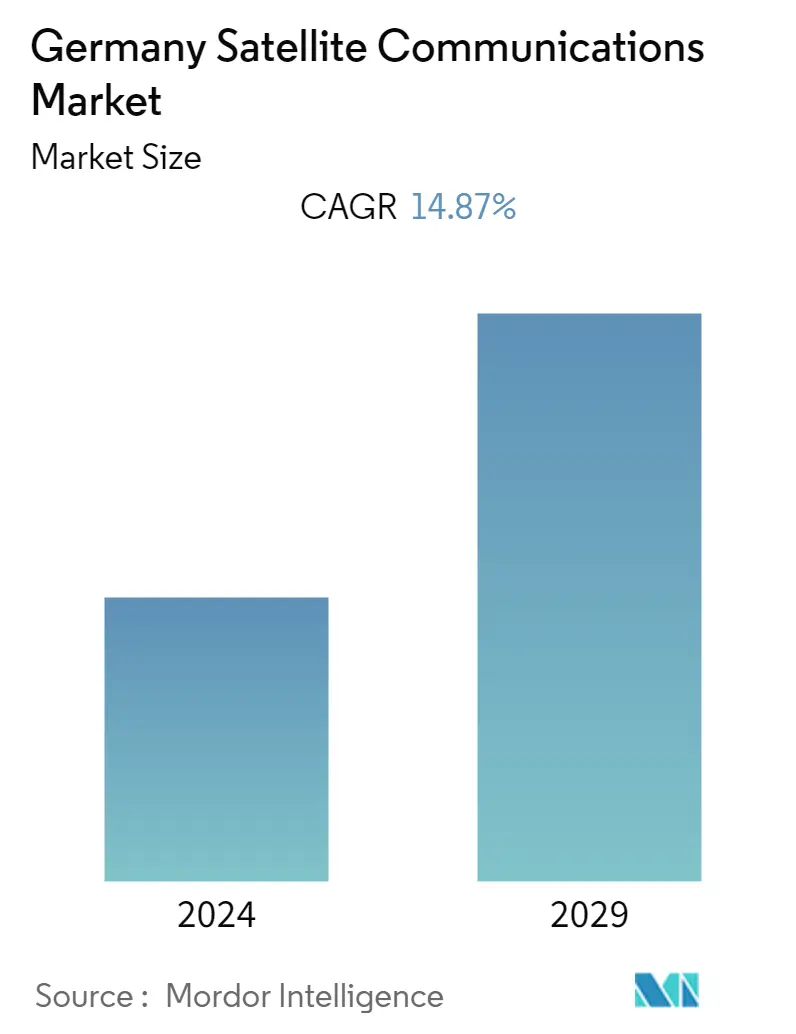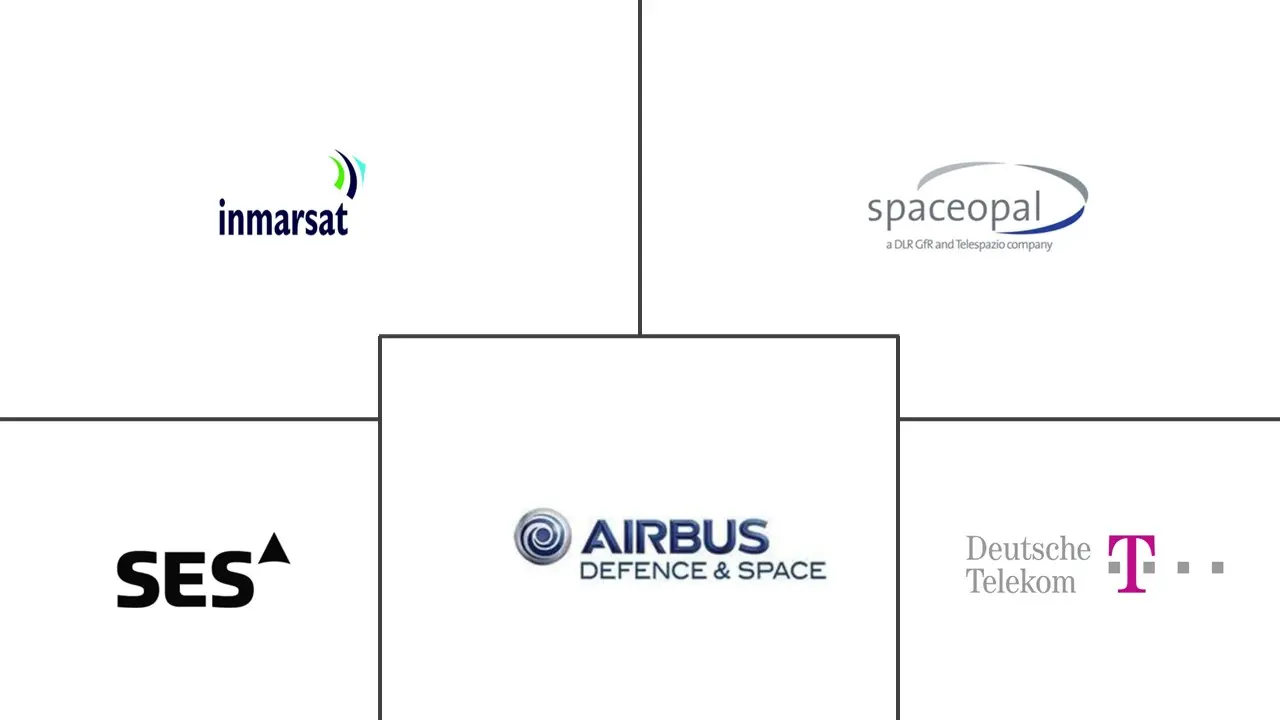| Study Period | 2019 - 2029 |
| Base Year For Estimation | 2023 |
| Forecast Data Period | 2024 - 2029 |
| Historical Data Period | 2019 - 2022 |
| CAGR | 14.87 % |
| Market Concentration | Medium |
Major Players*Disclaimer: Major Players sorted in no particular order |
Germany Satellite Communications Market Analysis
The German satellite communication market was valued at USD 1.56 Billion in the past year, and it is expected to grow at a CAGR of 14.87% during the forecast period to USD 3.52 Billion by the next five years.
- Satellite communication has grown in popularity in relaying information and creating communication among military personnel in the defense and military sectors. It also aids in satellite asset tracking and remote sensing. For example, life safety at sea is becoming increasingly important in the defense sector. Various governments invest in communication technologies like navigation systems and vessel tracking. The German government is vital in promoting maritime security, as the marine industry contributes to the region's economic prosperity.
- As satellite technology developed, end users' direct access to capacity has become a severe problem. Instead of the traditional emphasis on network connectivity, ISOs and independent satellite systems are increasingly directing satellite technology toward providing services to end consumers. The conventional wisdom in satellite communication has been that the size of the receiving equipment and the power radiated from a satellite must be traded off. The most cost-effective systems for connecting a relatively small number of sites employed low-powered satellites sending signals to big stationary earth stations.
- The industry's dependence on government contracts in various areas, including the highly reliable and survivable nature of satellite communications services essential for disaster communications and backup services, may insulate the industry from some of the more severe impacts of the global pandemic.
- The demand for broadband communications remains strong and is not necessarily geographically restricted. Such demands include connectivity requirements for users on aircraft, ships, and vehicles (including first responders) operating in fixed places and while in motion. These three platforms require constant connectivity along their travel itineraries, frequently passing through unserved sections of major metropolitan centers and less heavily inhabited areas. Such developments are projected to aid in the market's growth under consideration.
- According to the Satellite Business Association, the commercial satellite industry has proven critical in controlling the COVID-19 pandemic. The demand for satellite communication has increased due to its numerous applications in providing voice, data, and broadcast communications solutions, as well as navigation, earth observation, remote sensing, and other specialized services essential for businesses, government clients, and consumers domestically and globally. International space agencies, like NASA, have employed communication satellites to illustrate COVID-19's global consequences.
Germany Satellite Communications Industry Segmentation
The Germany Satellite Communication (SATCOM) market is defined based on the revenues generated from the types used in various end-user industries such as maritime, defense & government, enterprises, and media & entertainment, among other end-user industries. The analysis is based on the market insights captured through secondary research and the primaries. The market also covers the major factors impacting the market's growth in terms of drivers and restraints.
The scope of the study has been segmented based on the type of satellite communication equipment and services ( ground equipment (a gateway, very small aperture terminal (VSAT) equipment, network operation center (NOC), and satellite newsgathering (SNG) equipment) and Services (mobile satellite services (MSS), fixed satellite services, and earth observation services) and end-user industries (Maritime, Defense & Government, Enterprises, Media & Entertainment, and other end-user industries). Common satellite communication services include voice calling and internet access for different applications. The study tracks the key market parameters, underlying growth influencers, and major vendors operating in the industry, which supports the market estimations and growth rates over the forecast period. The study also tracks the revenue accrued through the sale of grown equipment and communication services that are being used in various end-user industries across geography. In addition, the study provides the SATCOM market trends, along with key vendor profiles. The study further analyses the overall impact of COVID-19 on the ecosystem.
| Ground Equipment |
| Services |
| Portable |
| Land |
| Maritime |
| Airborne |
| Maritime |
| Defense and Government |
| Enterprises |
| Media and Entertainment |
| Other End-user Verticals |
Germany Satellite Communications Market Size Summary
The German satellite communications market is experiencing significant growth, driven by its increasing application in defense and military sectors for information relay and communication among personnel. The sector is also benefiting from advancements in satellite technology, which are enhancing capabilities in asset tracking and remote sensing. The German government's investment in communication technologies, such as navigation systems and vessel tracking, underscores the importance of maritime security to the region's economic prosperity. The market is characterized by a shift from traditional network connectivity to direct service provision to end consumers, with a focus on integrating advanced technologies like artificial intelligence and the Internet of Things. This evolution is supported by collaborations between companies like Inmarsat and Blackned, which aim to provide integrated solutions for the German armed forces, and Airbus's enhancements to the SATCOMBw network for NATO commitments.
The demand for satellite communication is further bolstered by its critical role in providing broadband connectivity for various platforms, including aircraft, ships, and vehicles, which require constant connectivity. The market's resilience is partly due to its reliance on government contracts, which offer stability amid global challenges. The aviation industry is also witnessing the transformative impact of satellite communication, enhancing safety and reducing costs through real-time data relay. The market is highly fragmented, with key players such as Inmarsat, Spaceopal GmbH, and Airbus Defence and Space GmbH adopting strategies like partnerships and innovations to maintain a competitive edge. Recent developments include the extension of satellite communication systems for the German military and the launch of advanced communication satellites, highlighting the ongoing advancements and strategic importance of the sector.
Germany Satellite Communications Market Size - Table of Contents
1. MARKET DYNAMICS
-
1.1 Market Drivers
- 1.1.1 Increase in Internet of Things (IoT) and Autonomous Systems
- 1.1.2 Rise in Demand for Military and Defense Satellite Communication Solutions
-
1.2 Market Restraints
- 1.2.1 Cybersecurity Threats to Satellite Communication
- 1.2.2 Interference in Transmission of Data
2. MARKET SEGMENTATION
-
2.1 By Type
- 2.1.1 Ground Equipment
- 2.1.2 Services
-
2.2 By Platform
- 2.2.1 Portable
- 2.2.2 Land
- 2.2.3 Maritime
- 2.2.4 Airborne
-
2.3 By End-user Vertical
- 2.3.1 Maritime
- 2.3.2 Defense and Government
- 2.3.3 Enterprises
- 2.3.4 Media and Entertainment
- 2.3.5 Other End-user Verticals
Frequently Asked Questions
What is the current undefined size?
The undefined is projected to register a CAGR of 14.87% during the forecast period (2025-2030)
Who are the key players in undefined?
Spaceopal GmbH, Airbus Defence and Space GmbH, SES S. A, Inmarsat Global Limited and Deutsche Telekom are the major companies operating in the undefined.




